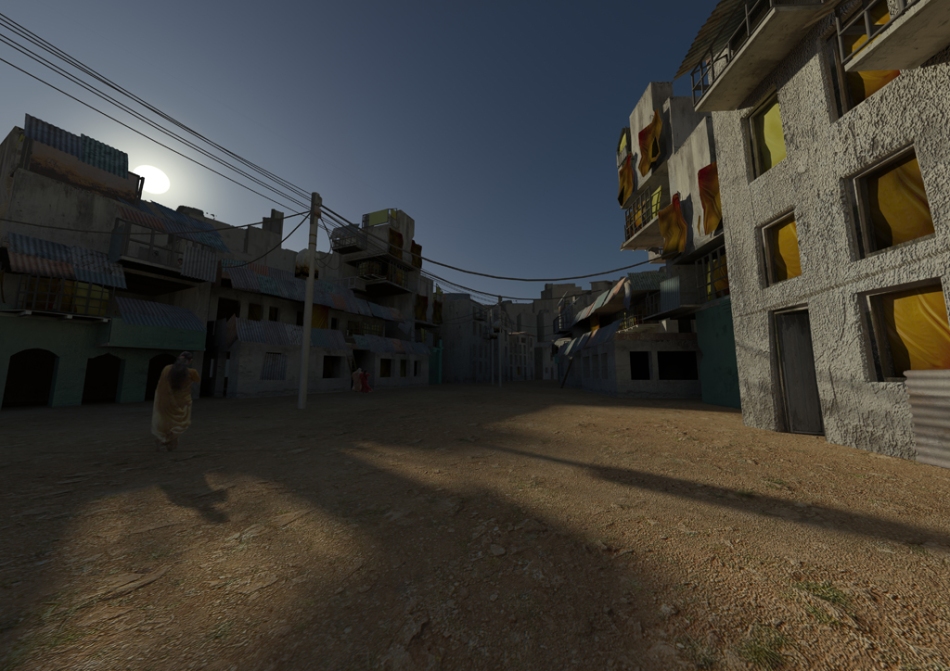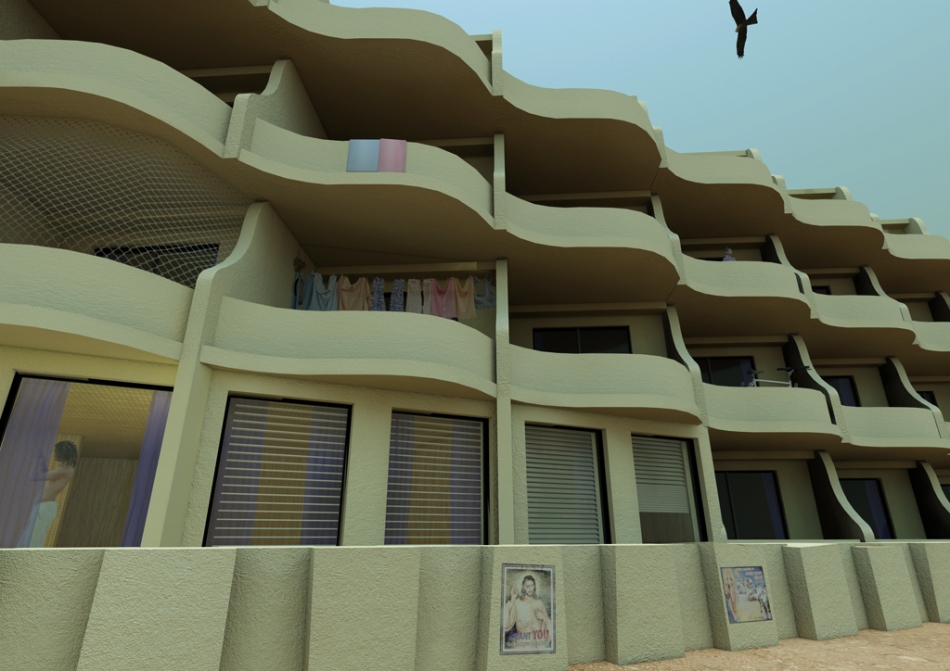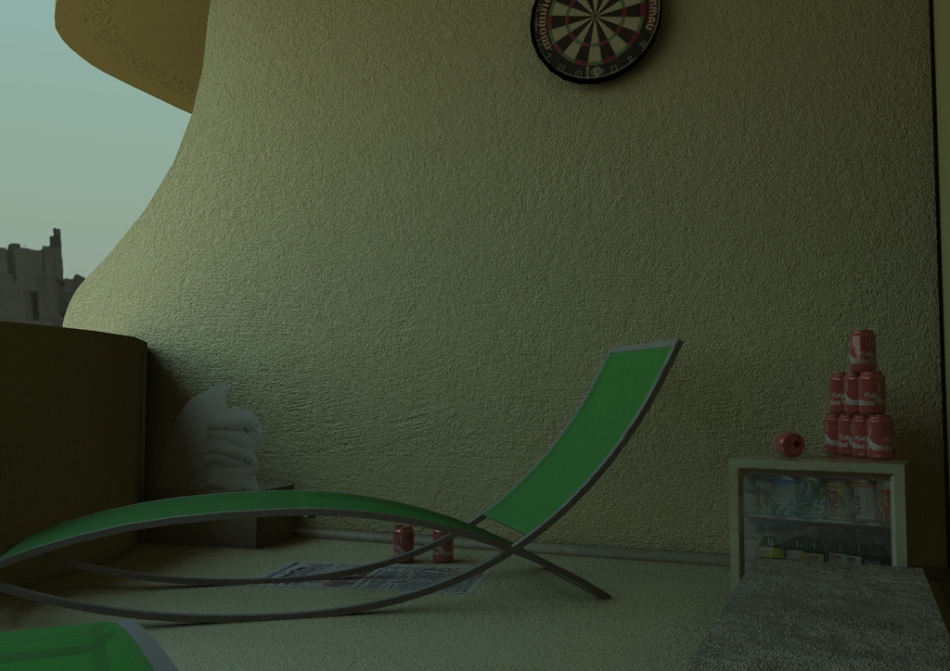Art Under The Bridge
I’m still thinking about what to put in the foreground. A ladder with some cans surrounding it where the artist was working until he or she decided to take the picture that you see? A cyclist going by on the cycle path. I need some traffic still. I’m not sure about the buildings on the right hand side, they don’t have the authenticity of the ones on the left. I am really happy with the way the scaffolding has turned out on the left.
Under the bridge
This is a test render for the bridge scene that I am currently working on. This image took 7hours (overnight) to render due to a high Depth of field sample setting and unfortunately the aperture is badly set. I wanted the background to be blurred but not the foreground where you should be able to see the roof where I am trying to capture the weight and strength of the concrete blocks.

[update] – It turns out that the displacement mapping on the ground material really slows down rendering. A flick of a global switch in vRay turns this off and returns things to normality. The displacement mapping on the floor was looking pretty good and I will finalise a good setting for this towards the end of the scene development. Below is the same scene without displacement mapping and DOF. (2 minute render!)

Road furniture next, development of background scenery, then a few cars from Turbosquid. I’ve just looked at an Alfa Romeo Brera on Turbosquid. It looked great, just what I need and free too. Then I saw 900,000 polygons! Been there, done that, got the t-shirt.
Final Street Scene
This is the final street scene with an appropriate level of DOF, masked AO and the odd touch up.
I am really happy with the results now.
🙂
Depth Of Field tests
V-Ray makes depth of field really easy if you use the render dialog with a standard target camera to measure the depth. You can alter the aperture to adjust the effect. Below are my small test renders I carried out today to find out what measurement would be suitable for the final render. These are interesting on their own, I really like the DOF effect. I’ve just found out about the Bokeh effect but which I’m excited about but that will have to wait for a while I think.
The file names indicate the Aperture size used in each case. eg: AP7_5 has an aperture of 7.5
Final touches to street scene
I have closed the ground floor curtains to reflect the fact that there is reduced privacy at this level. I’ve added graffiti which adds to the feel of the scene. Volume light has been used to add atmosphere at the windows. This really works and has significantly reduced the flat feeling that I was getting from the main brick wall. I’ve modified the galvanized materials. The balconies now have slight rusting and the main rails are significantly aged, possibly too much. I’ve reduced the bump level of the brick material. I’ve added moss to the main window texture and it looks far more aged now. I have also used an ambient occlusion pass to dirty up the scene and the results are pretty cool. I am really happy. The only thing I need to do is sort out the Depth of Field settings with the vRay Physical Camera. I’ve read up on it a few minutes ago and I have been mixing up Focal Length and Film Gate; resulting in slight DOF effect and long render times of a couple of hours, disappointing but I know what I need to do next to fix it.
Current street scene. This is the composite of the render and the ambient occlusion pass with a bit of Photoshop masking to reveal some details that the AO pass was hiding.
Petrol Stations
Petrol Stations are the queens of non-places. Second only to the Airport that wins because part of its land (between the plane and the immigration desk) is technically neither in the country nor out.
I went out this evening and I was gratefully amazed how easy it was to get permission to take photographs of petrol stations. The staff didn’t mind at all (as long as they weren’t in the shots).
I managed to get several shots that will allow me to fake the interior of my shop. I also found that there are many items occupying the space, not just the shop and the pumps. Many of the shots are for texturing purposes.
Nottingham Mutability Scene virtually finished
Only final touches and camera positioning needed. I have corrected the overlapping materials on the steps that can been seen in the plant pot balcony test render and the positioning of the CCTV sign has been altered too.
Enter Mutability
Using the photo montage of an earlier post as a guide post I am developing the scene further so it illustrates the change that the old Victorian factory has gone through to become a dwelling place.
Nottingham Back Alley Montages
These images are montages created in PS from the images taken in Nottingham the other day. I am really happy with the way these have come out. Photoshops Photomerge feature does a great job of stitching images together and takes far less time than it would take to get the same results by hand. You could argue that the blending is a bit rough in places but its saved me hours of time.
Presently…
I am
- carrying out adjustments to the models previously created and finalising the Flats/hotel building models.
- Finishing off my write up of Bachelards Poetics of Space.
- Shaping the powerpoint for the PgDip Assessment that’s coming up.
- (When the books arrive) Taking a look at Baudrillard, Debord and Jung to see if I can weave them into my work.
From Amazon I have ordered:
- Introducing Baudrillard by Chris Horrocks (Author), Zoran Jevtic (Illustrator)
- Simulacra and Simulation (The Body in Theory: Histories of Cultural Materialism) by Jean Baudrillard (Author), Sheila Glaser (Translator)
- Society of the Spectacle by Guy Debord
- Jung: A Graphic Guide (Introducing…) by Maggie Hyde (Author), Michael McGuiness (Author) (His red book is expensive I want to know if its likely to be worth the money.)
Updated image:
Latest new image:
Whilst I was in the University library I got talking to one of the librarians because of the Calcutta book that I have been renewing since I started my MA. He told me stories about his time in India. He told me one particular story of how one afternoon he was reading the paper drowsily on the balcony of the place where he was staying when he became aware that he felt like he was being watched. As he lowered his paper to take a look around he realised that on the edge of his balcony looking at him… waiting… was a Vulture!
Hotel Balcony Composite
This render is a final render of this balcony. I have adjusted the camera height so that the focalisation of the scene is from an occupants point of view. This creates the feeling of presence in the viewer and a sense of implicit involvement in the scene. The items in the scene have been re-arranged so that they are used to better effect.
Pop-up book city
I have loaded last nights renders & opacity maps onto planes and uses the Orientation Constraint to get the planes to follow the camera as it turns. This is really useful as the planes don’t actually move position, but rotate on the spot to face the camera as it moves.
These are the results from this evenings investigation into using this technique in my scene composition.
I have realised that using entire rows of buildings isn’t going to cut it, so I have rendered a set of individual buildings to use instead (see above gallery). I have found that while the Orientation Constraint is great, my opacity maps aren’t and need to hide everything but the building itself. I initially thought that I should leave the ground in view (not sure why, it just felt right) and leaving the buildings shadow in view seemed the right decision too.
Tonight’s work has shown me that the opacity sillhouette of the buildings cast good shadows – even from a plane. I have also learnt that having the ground in view on the background buildings just doesn’t work. I’m going to have to change that.
Shanty scene now ready for composition.
I have managed to get the corrugated roofing completed now and it looks just as good as the first high poly version. I have also created a set of backgrounds that I am going to mount on planes in the background to create the illusion of extra buildings without the polygon costs of actually putting them into the scene directly.
These are the backgrounds from tonights work. The last image is an example of the opacity map I am using with each of these so that I can show the scenes “real” sky and so I can cast reasonably realistic shadows:











































































